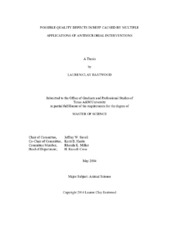| dc.description.abstract | This study was designed to address ground beef quality defects noted by further processors across the country. Multiple hurdle antimicrobial intervention strategies are commonly employed in all facets of beef product manufacturing to ensure the highest level of food safety possible. For that reason, a theory was postulated that repetitive antimicrobial applications may be responsible for lessened color shelf-life and reduced onsumer acceptability of ground beef patties. Four antimicrobial treatment combinations (hot water applied to hot carcass followed by hot carcass lactic acid application; Hot water applied to hot carcass followed by hot carcass lactic acid application, followed by a pre-fabrication cold forequarter lactic acid spray; Hot water applied to hot carcass followed by hot carcass lactic acid application, followed by a pre-fabrication cold forequarter acidified sodium chlorite spray; Hot water applied to hot carcass followed by hot carcass lactic acid application, followed by a pre-fabrication cold forequarter Beefxide spray); in addition to a control (hot carcass lactic acid spray only), were used in this study. Following carcass treatments, trimmings were assigned to one of four treatment groups (acidified sodium chlorite, Beefxide, lactic acid or control). Trimmings were sprayed following forequarter fabrication and were subsequently held in cold storage for 48 h before grinding. Ground beef patties were produced from each trimming subgroup (n = 40) and designated for shelf-life, consumer panel, or trained panel evaluation. Beef patty temperature, pH and color (L*, a*, b*) measurements were taken on the day of patty production, in addition to daily color measurements taken over the 5 d shelf-life period. While some visual darkening of patty color occurred by the completion of the shelf-life period, few significant changes were seen in color space values for each treatment combination. Although there were some significant interactions reflected in consumer panel scores, there is no clear trend describing interaction effects and consumer ratings. In general, findings from this study support that food safety interventions, while effective in reducing microbiological counts on product surfaces, do not negatively impact beef patty quality. | en |


